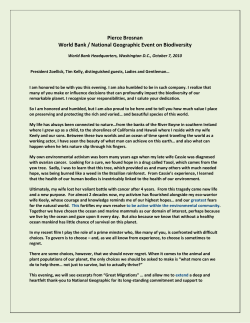
Document 4230
PROGRESS and the THE COMING AGE OF ABUNDANCE: THE DECLINING SCARCITY OF NATURAL RESOURCES Stephen Moore February s, .;T;: 2 li ^,'; A Project of the Competitive Enterprise Institute 1995 THE COMINGAGE OF &WNDANCE: The Declining Scarcityof Natural Resources by Stephen Moore INTRODUCTION The twenty-first century maybe the first era in the history ofhumanity that naturalresource scarcityceases to act as a significant constraint on economic growth. Although this is by no meansinevitable, every measurabletrend ofthe past century suugSests that humanity will soon be entering an age of increasingand unprecedentednatural resourceabundance. This is admittedly an extraordi~ and controversialprediction to make. It contradictsvirtually everything that we read in the newspapers,Mew on teletisioR and are told by many prestigiousacademicscholars. We areroutinelydelugedwithpreciselytheoppositemessage:that humanitywill soonbeenteringaneraofsevere, and perhapscatastrophic,physicallimits to growth The prediction that we may soon be entering an age ofresource abundancealso seemsto collide with pure common sense.There are already5.6 billion people on earth eachof whom consumevaStquantitiesofthe earth’snaturalresourceseveryday.That numbermaydoublebytheyear2050alone. Andalarger population meansmore consumptionofthe earth’s energysources,minerals.and other natural resources. As Herman Dalyofthe WorldBank hasinsisted.morepeopleusingmoreresourcescan continueindefinitelyonlyifscientistsdiscover“awaytowidenthediameter ofthe earth.” ’ In other words, we seemto be speedingtoward a head-on For thepast one collision with the geological reality of resource scarcity hundred years virtually evey natural resource has experienced declining prices. Yet history provesthat the pundits, aswell asour intuitiok are wrong. For at least the past one hundred years virtually every natural resource has experienceddecliningprices. A drop in price is a market signalof/u, not ntol~’ scarcity. Figure 1 shows how the composite price of I3 major minerals,metals,and energy sourceshaschangedsince 1900. The prices are indexedto the wage rate. This yields a uset3 statisticthat allows us to comparefor any two points in time the numberofhours a worker hadto work to purchasea given quantity of these resources. The results co&m the conclusion of a long term trend toward increasingresource abundance: Moore: TheCorningAge of Aburxixm PROGRESS and t 11 e PLANET 2+ .Nattnal resourcestodayareabouthalfasexpensiverelativetowagesastheywerein 1980~ l Natural resourcesare three times lessexpensivetoday than they were f&y years ago. l Natural resourcesare roughly eight ties lesscostly than they were in 1900. Howisitpossiblethatevenasweuseeverincreasingamountsofseeminglyfiniteamountsofnaturalresources, they still declineover time in price? Part of the explanationliesin the fact that technological improvements andadvancesinproductivitycontinuallyoutpaceourconsumptionofresources. New miningtechniques,for example,haveopenedthedoorstovastnewquantitiesofmineralsthatwere neverformerly thought to be available.Fifty yearsago it would havebeen inconceivablethat oil could be minedfrom the bottom ofthe oceanor that The histov ofprogress oilcouldbeproducedf?omsand(orshaJe).Yettodaywehavetheknowhow is one of human@ .k to obtain huge quantities6om eachofthese sources. But, one might ask might this be only a temporary benefit? Aren’t there, infact, onlylimitedquantitiesofoilandotherresources,whichmaybelarger thanwepreviouslyrealized.but stillnot iniinite? Yes-andno. Thehistory ofprogressisoneofhumanity’sabilityto produceincreasinglevelsofoutput and wealth with decreasingamountsof natural resourcesand humantime and effort Moreover, the paceofthis progressthroughout the pastcentury haspersistentlyaccelerated,rather than slowed. And it hasdone so despite the increasein population. ability to produce increasing levels of output and wealth with decreasing amounts of natural resources and human time and eflort. As we progresstInther into the current information age,the notion oftinite physicalresourcesis becoming all the more outmoded. At a pace unparalleledin human history, man’s ingenuity is unlocking ever more spectacularadvancesin technology andscientificknowledgethat are further advancingour masteryoverthe hnite physicaluniverse. Thispointismostvividlyillustratedbythebreathtakinglyrapiddevelopmentsnowtakingplaceinthecomputer microchipindustry3 The microchipis slightly larger than the sizeofa man’sthumbnail. It is madeofsilicon, or sand - a natural resource that is in great abundanceand has virtually no monetary value. Yet the combinationofafeWBainsofthissandandtheinfiniteinventivenessofthehumanmind,hasledtothecreation ofa machinethat will not only createtrillions ofdollars ofadded wealth forthe inhabitantsofthe earth in the next century.butwilldo sowithincomprehensiblyvastsavingsinman’sphysicallaborandtheearth’s natural resources.Today,asinglemicrochipiscapableofretainingasmuchinformationasiscontainedinallthebooks inasmaUcommunitylibrary.Bytheendofthiscenturythecomputerindustrycouldpotentiallyreleaseamicrochipwith the capabilityof retainingand processingall oftheinformation containedin everypublication in the U.S. Library of Congress. Even ifthe world’s population were to double every fifty years,the microchip is doubling in capacityroughly everyfour years. This is a geometricalrate ofgrowth that is severalmagnitudes larger than population growth. Herein liesthe explanationfor the seemingparadoxofthe abundanceofnatural resourcestoday asmeasured bycontinuouslydecliningprices.Humanity’singenuityhasledtothenetcreation, overtimeofmoreresources that are availableto us and future generations,not less. Moore: The Coming Age of Abundmce c THE MODERN DOOMSDAY MINDSET Throughout the 1990sAmericanshavebeeninundated with horror storiesabout the demiseof the planet. Never was this more apparentthan in September 1994 when the international environmentalcommunity gatheredin Cairo for the WorldPopulation Conference.Thedelegatesfrom over one hundrednationssigned adocumenturgingthat the world community shouldjoin together to work toward a policy of population stabilization. “What is needed,” the Humanityk ingenuity conferencereportstated.“isasustainablebalancebetween humannumbers has led to the net and the resourcesofthe planet.” Among world statesmen,there was little dissentfrom this opinion. creation, over time, of that aI%? In large part theseconcernsof political leadersonly reflect the consensus opinion of most academics- particularly demographers, biologjsts, available to us and geologists, and environmentalscientists. For example,one of the most @we generations, not widely-quoted academicson population issues,biologist Paul Ehdich of Stanford University, recently noted: “We are literally using up in a few less. generationsthebiologicalandmineralwealthoftheEarththattookmiltions and millions of years to create.“4 He ridiculed the idea that economic progress can solve the ecological problems ofthe globe as “growth mania” which he describedas“a fixation on growth for growth’s sake. It is the creedofthe cancercell.” I Lester Brown. editor ofthe annualS/L& of ihe WorW report, concurs with this anti-economicgrowth visionasthe only way to savethe planet. Brown writes that “current notions of economic growth. .areat the root of so much ofthe earth’s ecological deterioration.” mOi%? KSOUKeS Another highly influentialenvironmentalist,Barry Commoner ofthe Centerfor Biology of Natural Systems hasaddedhis voice to the choir Commonerrecentlylamented:“Ifwe do nothing andjust continuethe way we are, using 95 percent of our energyfrom fossil tieIs, it will create an economic collapselong before 50 yearsfrom now.” Even the Vice Presidentofthe United Stateshasbecomea fervent and influential disciple ofthe doomsday logic. In his best-sellingbook Earth in the Balance. Al Gore lamentsthat fUturegenerationsofAmericans “will look back on 1990, at the kind ofecological destructionwe have,andwill wonder, as they shaketheir heads,how people could havethought in ways that allowed them to condone that kind of activity” 6 Of course,thesedoomsdayoutlooks and predictionsare anything but new. Just over twenty yearsago, for instance,the Club of Rome releasedits highly intluentialLimifs to Growrh report, which predictedthat over the next thirty yearsunbridledpopulationgrowth would leadto massfaminesand severeshortagesofenergy, minerals,trees,and other preciousresources.’The book’s famousconclusionwas that “shortagesofnatural resourcestill leadtoadismal anddepletedexistencebythebeginningofthenextcentury.” LintifstoGmvth was recently updatedwith a new title, Bqm/ihe Limirs. The new version attemptsto validatethe earlier conclusionsandthenglumlyreponsthatresourceandenvironmentaltrends Doomsday outlooks are much worse today than even previously suspected andpredictions are anything but neW. In 1980. this apocalypticvision of the future receivedthe official sanction of the U.S. Eovemment when the Carter Administration released its frightening &al 2000 report.’ The $1 million report sponsoredby the StateDepartmentandtwelve other federalagenciespredictedthat most resources- energy.minerals,food, and forests-would be in severeshortageby the year2000 “ifpresent trends continued.” It also predicted Moore:TheComingAgeof Abundance 3 PROGRESS and t IL e PLANET 44 that“theworld’speoplewouldbemuchpoorerthantoday(l980).“Theseterrifyingpredictionscommanded headlinesthroughout the nation9 We will reservejudgment on the accuracy of thesepredictions for later, The point here is that this apocalypticoutlook was the prevailingview ofthe U.S. government at the end of the 1970s. In the Reaganyears of the 1980s the shifi toward a f?eemarket-basedgoverning philosophy led to the abandonmentofthese apocalypticviews. Indeed,most ofthe callsby Carter administrationofficialsfor price controls, population stabilization policies, the developmentof synthetic fuels.governmentfimded conservationprograms.commandand control‘Pvoven reservesof tpe energyrationing, and stricternaturalresourceregulatory policieswere virtually all important not only ignored, but pre-existingcontrols were in many caseslieed. minerals have s&y- TheClinton administratioq not swprisimglygivenVice-PresidentAl Gore’s environmentalphilosophy, has re-embracedmany of the environmental rocketed since 19.50.” groups’ concerns over world population growth and natural resource scarcity In sum, the United Statesgovernmenthasreturnedfull circle to once again promoting the “limits togrowth”govemingphilosophy andpolicyoutlookthatwasfirst popularizedtwodecadesago bytheclub of Rome’s work. How much stock should we put in thesefears? TAKING INVEWIDRY OF THE Pm In late 1973, asthe United Statesfound itselfin the grip ofan energy crisis,Newwerk magazinededicated its cover story to the haunting question:“Are We Running Out OfEverything?” ” What we really needto ask is: How do we even go about objectivelyansweringthat question? Oneway to measurethe stock ofnatural resourcesavailableis to examinethe quantity of”known reserves.” EnvironmentalanalystJerry TayloroftheCato Institute recentlycompiledthe statisticsforreservesoftwelve strategicnaturalresourcesin1950andin 1990” (seetable1). Taylorfoundthat“provenresewesoftirtually all important mineralshave skyrocketed since 1950.” I2 Only reservesof tin fell over the past forty years Perhapswhat is most surprisingin thesetrendsis that “proven reserves”for oil and gas haveclimbedby over 700 percentsincethe 1950s. This is roughly equivalentto a five hundred year supply of know reservesof fossilfuels. How can reserveshavegone up? The answeris they havebeennewly discovered,or newly made feasiblyaccessible.The data in table 1 not only calIsinto questionthe idea that we face imminentscarcityof the earth’s resources,it also contradictsthe standardnotion that for every barrel ofoil humanity uses,there is one lessavailableto us, our children and our grandchildren. YetthetnrthisthatthesomewhatencouragingdatainTable 1provesverylittleaboutthelongtermavailability ofnatural resources. The table shows that as of 1990 we had 350 million metric tons ofknown reservesof copper. Does this meanthen that asthe ezrth’s growing population usesup this 350 million ton reservethat theearth’sinventorygaugetillthenhit empty?Theanswerisno. Provenresewesmerelymeasuretheamount ofa mineralthat can be extracted economicallyat any given point in time given current prices and current technologicalcapabilities. As Taylor emphasizes,“Proven reservesare a function of economicsand knowhow, not geological abundance.”‘I Indeed, aswe examinecurrent trends in industry we seethat firms are movingaggressivelytowardfindingwaystoholdlessinventoriesofgoodsandservices,throu&suchpractices Mcwre: The Cauiin~ Age of Abuuduce c j as the ‘Sust-in-timeinventog methods. Yet we don’t fear that we are running out of the supply of milk becausethe Seven-Elevenstore holds only a three day’s supply. Similarly,we should not expectto run out ofcoppersimplybecausecopperminingcompaniescalculatethattheyonly have a certain number of years of reserves. When they use ap those The best, andperhaps reserves.they&l havearenewedincentivetolocatenewsourcesofsupply. the only reliable, meaSureof a resourceb supply is the change in its market price. As a resultofthese defects,the best,and perhapsthe only reliable,measure ofaresource’ss~pplyisthechangeinitsmarketprice’~ Pricesarethemost objective way that economistshave of measuringthe relative scarcity of goodsandsewices.Arisingpriceofacommodity,goodorsewiceisasignal that demandis outstripping supply (or is expectedto outstrip supply in the future) and that a shortage may emerge.‘I This samelaw of supply and demandappliesto natural resources. If there were an impending shortageof coal,copper>rubber, or tin. thenbuyersandsellerswould consistentlybid up their price. Conversely,ifa huge new reserve of oil were discovered, or demand for oil were expected to drop becauseof the sudden introduction ofan alternativeenergysource,buyersand sellerswould consistentlybid down oil prices In sum, a rising price ofa resourceindicatesincreasingsupply relative to demand;a falling price indicatesdeclining supply relativeto demand.16 It is noteworthy that even the doomsayersacknowledge that increasedscarcity necessarilytranslatesinto higher pricesofthe resourcein question. One ofthe consistentand dire predictionsofLim;ts 10Growth was that with lessavailabilityofresourceswe can expectever increasingprices. Similarly,Barry Commonerhas writtenthat“each barrel ofoil drawnfiomtheearth causesthenextone to bemoredifficult to obtain.. .The economic consequenceis that it cc~sesfhe price fo incrw.w cot?tim~~sly” (emphasisadded).” A final examplecomesfiomtheGloha12000Re~~. Itpredictedthat non-!%elmineralpriceswouldriseby5percent per year through the year 2000, as a consequenceofimpending scarcity So it would seemto be a generally acceptedpropositioc fromdoomsayersandresourceoptimistsaliie,thatifweareenteringanageofresource scarcity,wemzrrlobserverisingprices.Fallingrealpriceswouldbeincompatibletith theconceptofresource exhaustion. Somedo argue, however, that the price of a resourceor raw material may only reflect the availablesupply today, wt the relative abundanceor scarcity in t%tureyears. If world population growth were to place enormousnew demandpressureson resources.then evenifthe priceshad beenfalling inthe past,they maysuddenlyandsharplyrisein the future. Yet Falling realprices this common argument reveals a deep misunderstanding of how the would be incompatible modem-dayprice systemoperates. with the concept of resource exhaustion. Today’s price of oil reflectsnot only the availabilityofthat resourcetoday relativeto demand,but its expectedavailability in the future. An asset’s valueis determinedby the discountedpresentvalueof its future return If themarketbelievedthatoil wasgoingto beir short supplyinten years,then ownerswould bidup pricesrodq. And any singlemarketanalystwho 6rmly believedthat oil priceswill soarin the !%turecould buy oil at today’s prices,hold on to it, and sell it in the future at the expected higher price, Indeed one would not evenneed to take physicalpossessionofthe resource. There are now htures marketsfor most resourceswhich allow Moore TheComingAgeof Abundance P R OGRESS and * h e PLANET 64 traderstopurchasethefutureresalerightsofoil,orporkbeUies, orothercommodities. Andindeed.thousands ofspeculatorsdo this;they hoard gold, copper,chickens,farmland.orwhateverthe resourcethat is expected to grow scarcemight be. In sum the priceofanatural resourcetoday not only equilibratescurrent supply and demand,but reflectsthe market’sbest estimateabout the&u= levelsofsupply and demand. There is no law of naturethat saysthat the market is always setting the right price. Speculatorswho bought oil fUturesin the early 1970sand then soMthemin the late 1970smadea forhme. Speculatorswhobought oil t%uresin the 1980slost fortunes,But the market price doeshavethe virtoe of incorporating all ofthe best and most relevantinformation we have available. RESOURCEPRICE TRENDSOVER m LONG TERM There is no conceivable f&p&icting any Historical price data for natural resourcesin the U.S. are readily available case fiomstandardgovemmentsources.Forsomeoftheresourcesthesefigures datebackasfaras 1800.‘8Thefollowingsectionsexaminethepricetrends world shortage of forthreecategoriesofresources:energy forestproducts,minerals.andraw basic ym materials. materials. Mineralsare commonlythought to be“nonrenewabie” resources.For this reason.mostanalystsbelievethat theseresourcesmust be becoming more scarceover time -almost by definition ..Yetthe long term price trendsforthe 13mineralsintable2revealsthatrelativetotheconsumerpriceindex,all butfouroftheminerals havedeclined in real price over the past 100 to 150 years That is, the price of most mineralshas declined relativeto the price of other goods and setices. Antimony, platinum and tin are notable exceptions, Relativeto wages. however, all but one mineral(platinum) havefallen steeplyin price (seetable 3). Most of themineralsatthetumofthecenturywerefiveto tentimesrnoreexpensivethantodayintermsofthenumbers ofhours ofwork neededto purchasethem. As an example,the declinein lead pricesrelativeto wages since 1820 is shown in figure 2. The steadydecline in mineral prices is attributableto severalfactors. One of these has been the constant discoveryofnew mines. A secondhasbeennewtechnologicalinnovationsin mining techniqueswhich lower the cost of resourcerecovery andallow mining 6om areaswhere excavationwas previouslytechnologically andeconomicallyinfeasible.Finally, the introduction ofless expensiveor superior substitutesfor the use of someminerals- such asthe use of more efficientfiber optic cablesin placeof copper telecommunication cables- havelowered demandfor some of thesecommodities. Pricedata for basic raw materialsare unforhmatelyonly availableback to 1960. But astables4 and 5 show, the pricesofcement, glassand metalshavedeclinedrelativeto prices and wages sincethen~The worldwide price trends for theseraw materialsare muchthe sameasfor those in the U.S. There is no conceivablecase for predicting any world shortageofbasic raw materials. Over the past century energy prices in the U.S. have fluctuated substantially. Unlike many other natural resources.most ener-q prices, indexedby consumerprices,are no lower today than in the early 1900s(see table6). The exceptionisthe price ofelectricity, which today is only one-halfto one-third its levelin the early Mwre: The Corning Age of Abmdance l part ofthe century. Relativeto wages,however, all forms of energyhaveexperiencedprice reductions. In 1920, for example,asshown in table 7, the wage-indexedprice ofoil was roughly twice its current level,the price ofelectricity was sixtimesaboveits current level,and coalwas almostseventimesmore expensive.The data for thelong-termtrendinoilpricesindexedbywagesisshowninfipure3. Likeallothernaturalrescurces, energy is not becoming more scarceover time, it is becoming more plent&l, just not as rapidly as other commodities. THE RECORD M THE 1980s Sowe seethat for almostall basicnaturalresources,the longtermtrendsarealmostuniversallyin the direction oflowerpricesandgreateraffordability Nowwearriveatthecorequestionofthischapter: Havethesetrends continued in recentyears? Or to put it anotherway, how havethe predictionsofPaul Ehrlich, Lester Brow% Global 2000, Limits to Growth, and other leadingde&is& comparedwith the actual evidenceover recent years? Let’s examineeacharea separately. Minerals Back in 1976 Paul and Anne Ehrlich projczted that “before 1985 mankind will enter a genuine age of scarcity...inwhich theaccessiblesuppliesofmany key mineralswill be facing depletion.” I1 A few yearsprior to that the authorsofLimits lo GrowrthMote: “Even taking into account sucheconomicfactors asincreased priceswith decreasingavailability,it would appearat presentthat the quantitiesofgold, zinc, andleadarenot sufficientto meetdemands.At the presentrate ofexpansion...silver,tin, and uraniummay be in short supply at higher prices by the tom of the century.” m Virmallyallofthosepredictionscannowbeprovenwildlyinaccurate. Figure4showsthatfrom 1980to 1990: . Ofthirteen mineralsexamined,elevendeclined in price. The two exceptionswere manganeseand zinc. . The real prices ofantimony, mercury, platinup siiver,tin, and tungsten declinedby more than 50 percent over the ten year period. . Copper, lead, and magnesiumprices dropped by 20 percent over the decade. Contrary to the statedpredictionsofLimi?s fo Growth, silver,ti& uranium and lead havelower pricestoday than in 1972, not higher prices Only zinc hasrisenin price aspredicted. As for the Ehrlich’s claimthat “by 1985 many mineralstill be facing depletion,” we now know that it is plainly and completelyfalse. Raw Materials On a recent popular televisionshow. “The Nature of Things.” co-hosts Anita Gordon and David Suzuki lamentedthat “our insatiableappetitefor more of the planet’s resourceshas finally caught up with us.” I’ Meanwhile Paul Ehrlich recently wrote of the past ten years that we cannot afford “another catastrophic decadelikethe 1980s.” ?2This is the kind ofpublic informationthat is disseminatedabout raw materialusage in the 1980s. Are we really running up againstlimits? Moore: The Coming Age of Abundance 7 PROGRESS and t h e PLANET 84 No. In the 1980salmost all raw materialsdeclinedin price. Figure 8 showsthe fall in pricesofcement, glass, rubber, and a composite index of ail metalsbetween 1980 and 1990: . Glassprices fell by 34 percent. . Cement prices fell by 39 percent. . Metals prices showed a 15 percent decline . Rubber prices declinedby 40 percent. In fact, contrary to the unending rhetoric about the over-consumptionof the 1980s.this was a decadeof enormousincreasesin the supply of resources. Economist G.F. Ray recently reported that the 1980s“will go down in economic history as a period when [the price] of primary products hit rock bottom whatever method is used to illustratetheir real valueof purchasingpower. There havebeenhardly any exceptionsto this decline.”23 Throughout the 1970s as America was held hostageto the OPEC oil embargo,it becamecommonplaceto seenewspaperstoriesandtelevisionreports predictingmassiveand worsening energyshortagesasthe world entereda new era of scarcity Oil prices were expectedto reach $50 per gallon or more by the year 2000. Lengthy waiting lines at gas stationswere expectedto becomea routine occurrence. Energy conservation and price controls were the public policy prescriptionsof the day. Jimmy Carter urged stores and public buildingstotumthethe~ostattowhatN~~wrrkdescribedas“achilly65 degreesinthewinterandnolower than a sweaty 80 in summer.” The nationalDemocratic patty endorsedgas rationing as a way to slow the impendingcrisis. Seeminglyeveryonewas caught up in the hysteria. PresidentJimmy Carter gloomily predicted in 1977that “we could useup all of the proven reservesof oil in the entire world by the end ofthe next decade.” zi Two environmentalscientists,LawrenceRocksandRichardRunyon,releasedawell-publicizedbookin 1972,77te ,%qy Crisrs, which declared:“During the next two decades,severeoil and gw shortagesare inevitable! We shallbe powerlessto infuseenergy sourceson a sufIiciently massivescaleto meet the demandsof our industriallife-support system.”26They saidthat at current ratesofuse, the earth held 30 yearslet?ofgas and 20 yearsleft of oil. FederaJofficialsalmostallagreedwiththisa.ssessment. TheViceChaitmanoftheFederaJPowerCommission in 1971,JohnA. Carver, describedthe energycrisisaheadas“endemic and incurable.” He continued: “We cananticipatethat beforethe end ofthis centuryenergysupplieswill becomeso restrictedasto halt economic developmentaround the world.” 27 How did thesepredictionsfare? Today, in 1994,oil doesnot sellfor $50. or $40 or even$30 per barrel. The current price is below $20 a barrel. Contrary to the doom and gloom forecastsof soaringenergy prices,the 1980swere yearsofgradual. and at timesrapid, energyprice reductions(see fiyre 6). This trend reversed the upward spiral of the 1970s. . Oil prices fell by 35 percent. . Electricity prices fell by 14 percent. Moore: Tlx Coming Age of Abundance . Coal prices fell by 47 percent. . Natural gaspricesfell by only 4 percent. (Natural gas was still under price controls in the 1980s.) A July 1991New York Times story buried in the Businesssectioncontrastedthe actualenergysituation in the 1990swith the predictionsmadeten to hventy yearsearlier. The Timrs reported that “adjusting the price ofgasolineat thepump toreflectchangesintheconsumerpriceindex,theaveragepticeinthefirstfivemonths ofthis year, $1.15, was 6 percentlower than in 1972,the year before the OPEC oil embargo.” zBGasoline prices may seemhigh today, but that is only becauseof the general intlation of the past twenty yearsand becausetaxeson gasolinehavesurgedto over 35 centsa gallon in manystates Yet the pm-tax price is lower todaythanat anytimesince1947.“Thegoodolddayswhenit comestooil prices,arenow,“recentlyexulted Daniel Yergiq energy historian at CambridgeEnergy ResearchA.ssociates.‘9 WorldwideResourcePrice Th& ThereductionsinpricesintheUnitedStatesinthe 1980spresentedabovewereenjoyedbyconsumersofother nations as well. The World ResourcesInstitute recently compiled worldwide indexesfor more than 50 commodities-rangingf?omPeruviantishtoMalaysianaluminum (seetableS). Allbuttwooftheresources declinedin real price. For consumersall over the world, natural resources havebecomemore affordablesince 1980. The objective, scientific evidence available today reveals that the prophets of doom were wrong in virtually every prediction they made. . The worldwide real price offood declinedby49 percentbetween 1980 and 1992. . The worldwide real price of petroleum declinedby 62 percent from 1980 to 1992. . The worldwide real price oftimber fell by 13 percent6om 1980 to 1992. . TheworldwiderealpriceofmetaJsandmineralsfell by38 percent from 1980 to 1988. In sum the objective.scientificevidenceavailabletoday revealsthat the prophets of doom were wrong in virtually every prediction they madein the 1960sand 1970swhen they forecast increasingnatural resource scarcityandrisingpricesofcommodities.Inthe 1980sintheU.S. andabroad,naturalresourcesbecamemore. not less,plentiful. Those trends havegenerallycontinued in the early 1990sso far. WHY THE DOOMSAYERSGET IT WRONG Thepersistentpticedeclinesofthe1980sthoroughlyconfoundedthedoomsayerswhohadpredictedprecisely the opposite course of events. Yet it is important to emphasizethat a vocal minority of scientistsand economists,suchasJulianSimonandHermanKahn,correctlyforecastthepricetrendsofthepastfifteenyears. At the time these scholarswere wnmarily dismissedby critics as holding views that are outside of the mainstreamand irresponsible.” In 1980,oneofthose“outsidethemainstream” economists,JulianSimonofthe UniversityofMaryland, bet Paul Ehrlich $10,0C~Ithat the real price offive natural resourcesof Ehrlich’s own choosing would be less Moore: The Coming Ageof Abundance PROGRESS and * h e PLANET IO 4 expensivein 1990than in 1980. All five ofthe resourceswhich Ehrlich chose- copper, chrome, nickel. tin. andtungsten-feNin price and Ehrlich lost the bet, aschronicledin 77wNew York TimesMagaz~e not long ago.3’ Inthefaceofamountainofevidencetodaythattheenvironmental predictionsofthedoomsayerswerewidely off-target, many of thesepundits now maintain that their reports issuedvaluable warnings and led to the implementationofpolicyprescriptionswhich helpedaverttheecologicaldisastertheyhadpredicted.Thetruth is that the limits to growth corrective measuresthat had been urged were rejected outright by the Reagan administration,which preferred to focus on economicexpansionand wealth creation. IfLImits to Growrh and Global 2000 had beencorrect, the predictedpath toward severescarcity should haveacceleratedin the 1980s.notreversed.Priceandproductioncontrolswereliftedmtherthanexpanded. Mandatoryconservation programswere abandonedrather than extended. The windfall profits tax was repealed. The doomsayers routinely attacked thesepoliciesas wrongheadedand dangerous. Indeed we now havefairly compellingevidencethat it was preciselythegovernmentinterventionistresource policies of the 1970s that exacerbatedand lengthenedthe energy crisis of that unfortunate era. Take the experiencewithoilpricecontrols.Firstimplementedin1971,theobjectiveofthesepriceceihngswastoprotect U.S. consumersby preventingU.S. oil companies!?omcollecting “windfall profits” as a result ofthe higher pricesbeing chargedby OPEC. Instead the oil price controls had the following three effetis (seefigure 7): U.S. oil production fell t?om 11 to 9 1)Price conrroLsreLhrceddomestic oiIpro&ction millionbarrelsadayfiom 1971to 1980. Pricecontrolsmadeitunprofitablefordomestic producers to increaseoutput through more expensiveprocesses,suchas drilling deeperwells, fracturing steamor water injection, off-shore drilling, and so on. Oil price controls The energy crisis in brought new drilling in the U.S. to a standstill. 1970s was mainly the 2) Price controls increased KY. oil commpfiorr Oil consump- attributable to tion by U.S. householdsand industry increasedhorn 15 to 19 millionbamelsofoiladayfrom 1970through 1978,becausethe price controls kept oil prices artificially lower than they would have otherwise been in the short term This discouragedconservation. Thanks in large part to price controls from 1975 to 1978 the real price of oil fell. These artificially low prices contributed directly to the wrenching 197Xto 1981 energy crisis. government fol/' 3) Price conr@ofsincreosedreliance onfore@ oil. U.S. imports of foreign oil rose from 4to 8.5 millionbarrelsofoil aday6om 1970to 1977,asdemandforoil roseanddomestic production fell. In 1981Ronald Reagan’sfirst act asPresidentwas to immediatelylift all oil pricecontrols. The impact was immediate: 1)Energv e~c;etlcyar,dco~~se~~~~;~~7 irrcremed. In 198 1 the price ofcmde oil rose from $29 to $36 per barrel atIer lifting price controls. By the end of 198I oil consumptionin the U.S. dropped by 20 percent. Moore: The Coming Age of Abundmce rose. OPEC commanded almost 60 percent of the U.S. market in the 1970s. By the end of 1981 after the lifting of price controls, the imported sharewas down to 45 percent(today it is about 50 percent). By January 1982 U.S. oil production rose by SOpercent above 1980 levelsand by 100 percent above 1979 levels. 2) Oil imports declined ami domestic prod&ion 3) Oilpricesevet~t~m/Iydeciit~edandOPEC’war defeated The increasedU.S. production ofoilledtoaglutinthemarketbylate1982.Asalwayshappenswithanincreaseinsupply, eventuallypricesbeganto tumble-from their high of $35 per barrel in 1981 to a low of$13 perbarrelin 1986.TwoyearsaflertheeliminationofenergypticecontrolsOPEC hadbeencrushed.A Timemagazinecaption read:“Down Down, Down: OPEC Finds that It Is a Crude, Crude, World.” 32Newsweek was even more to the point. writing: “OPEC: From Cartel to Chaos!” 33 In sum the energy crisis in the 1970swas mainly attributable to governmentfolly. Congresspreventedthe price systemf?om operatingproperly. When the market systemfor energywas permitted to function in the 1980s.the crisis quickly subsidedand American consumersenjoyed cheaperand abundantoil A casecould be madethat the very conceptthat is embracedby geologists of’finitenaturalresources”isaflawedwayofthinkingabouttheearthand nature. ‘Natural resources”only havevaluewhenhumanity inventsause for them.Y In the eighteenthcentury. humanity wortied about shortages ofthe major transportationform ofthe day, horses,and ofthe “iirel” that madethem run, rangelandfor grazing. In that sameera,the discoveryof a black gooey substanceknown asoil underneathone’s property actually depreciatedthe value ofthat property.3sHumanity had not inventeda use for it. Now it is valuedas one of our most vital resources~ Meanwhile. grazing land is relatively abundantand inexpensive. “hiatural resources” only have value when humanity invents a use fir them. Another explanationfor why we are often confronted with spectacularlywrong environmentalpredictions about the finure of the planet’s resourcesis that the traditional model for forecastingthe tI.nureavailability ofresources is irreparablydamaged. hmmy Carter’s Global 2000 report, for example,was a casestudy in the abuseof forecastingas science. Its dismalview ofthe future was basedupon forecastswhich assumed that “current trends till continue.” It is suchanalyseswhich lead to the conclusion that the earth till hold some 12 billion people by the middle ofthe next century or that the last barrel ofoil will be drilled from the earth early in the next century This type ofextrapolation analysisoften leadsto bizarre conclusionsx” For instance: . EconomistsCharlesMaurice and CharlesSmithsonofTexas A and M computed that if one were to extrapolatepublishing trends from the 1970s there would be 14 million doomsdaybooks publishedby the year 2000- or more than halfas many books asthere are in the entire Library of Congresstoday.?’ . At the endofWorld War II. economistsextrapolatingfrom the decliing birth figuresfrom the 1930spredicted adeclining U.S. population in the post World War E era and thus a period of“secular stagnation.” Thesepredictions were made only a few years prior to the baby boom and two decadesof economicprosperity.” Moore:TheCorningAgeof Abundance P R 0 G RESS and t h e PLANET . 77~Economisf magadne recentlydemonstratedthat by using “present trend” analysis, and dependingon the yearsone startsand endsthe data collection to developthe trend, very di!Terentconclusionscan be forecast. Trend analysiscould predict that by the year 2000 Amold Schwarzen~er’s earningswould top $360 million. But ifdiierent starting and ending points are chose& using the sameestimation technique one could predict Schwarzenegger’sincome to be 4130 million in 20~X.~~ As nonsensicalastheseestimatesmayseenSnoneofthemareanylessdefensiblethanprojectingthat resources will run out or that population will explodein the next century The rwon that the analysesarewong is that short term trends almost never continue, becausehuman beings adapt their behavior and change their environmentinresponsetochangingconditionsForexample.althougheconomicoutputin 1989wasroughiy 30 percenthigherthan in 1979, and althoughthe U. S. population rose by IO percentover this period, energy consumotionwasuaonlvrouzhlv3wrcent. Inotherwords.BTU’suerdollarofGNPwasroughly20percent - _ lower in 1989 than’in 1979. Inven;ive mindsrespondedto the economic incentivesof “‘the energy crisis” by finding ways to make industry and Short term trends consumersmore energyefficient. Trend analysiscannotaccount for such behavioralchanges.Forthisreason,reportssuchasC;loba/2OOOhavevety almost never continue, littlescientilicvalue. Their”contribution“istoneedlesslyscarepeopleand because human beings divert resources6om real problems CONCLUSION adapt their behavior and chaxge their environment in responseto changing conditions. Natural resourceshavebeengrowing more plentiful over the courseofthe pastcentury,asmeasuredbytheirprice. The decadeofthe 1980s contrary to popularbelieSwas no exceptionto this long term trend. Indeed,thanks to the steep across-the-boarddeclines in natural resource prices in the 1980s today manyofthe earth’s resourcesare at their lowest price everin recorded history Even as a growing population and a more economically developed society usesmore resourcesthan everbefore,ofnew technologiesand innovations,which make usmore efficientin consuming andproducingnatural resources,havemeantthattheearth’sresourceshavecontinuallybecomelessofalimit to growth over time, rather than more so. Eventhe U.S. governmentnow apparentlyrecognizesthe errors ofitsjudgments in the past Reversingthe forecastsof studiessuch as Global 2000, the Oflice of Technology Assessmentin 1988 concluded “The nation’s future has probably neverbeen lessconstrainedby the cost of natural resources.“” There is no inevitabilityofdeclining pricesofnatural resources.Unwisegovemment interventionpoliciesas wereexperimentedtithinthe 1970scanoffenhaveeconomicallyandecologicallydebilitatingconsequences. But ifpoliticianscan resist the ever-presenttemptationto intervenein natural resourcemarkets,America and the rest of the world face a surprisinglyrich resourcefuture in the twenty-first century. Mwre: The Cowing Age of Abundance ABOUT THE AUTHOR StephenMoore is director of fiscal policy studiesat the Cato Institute. He is a contributing editor at the Nalional Rev&w and his articlesfrequentlyappearin the Urn//S’OIW./~w~n/. Rem/d~ DIgm. and Hwww Ewnls. lnadditiontohis mostrecentbook, G‘o~www~t: Amwic~ :Y; / C~,ow~hfw&~oy,Mooreistheauthor of Slashir~gihe Defcir: A Rl?rrprbllforaBnla~f~~~~~f~~~f by I993 andPriwrizatiox A Slrtriqyfi~r Tcu,zit~g lhe Fe&-d B1rdge1(with Stuart Butler). Moore earned a B. A. in economicsat the University of Illinois. and did his graduate work in economicsat George Mason University. In I987 he servedas the research coordinatorforPresidentReagan’sNationalCommissiononPrivatization.In 1988hewasaspecialconsultant to the National Economic Commission. Moore:The Coming Age of Abundance PROGRESS ~Ths Progl~e\\ idtlcl Ilic k’l;ii~ci prt,j~~l ix 2 ~p:vg;!a~ i!f 1/1c (I’s~lwp~~liii\c i.lll;rtlxilc lclsiituic. Tllc ;litn ot ihi\ lpu~~j~~ri\ IO p~ci\at ~;:i~wl:!~~l~;III:$ ws 01’ \uh.jcL.l\ IIIAI as-e I~c:~ted iu tlic IICXLII (11’IIUII~:I~ ci\ ili,ril:~.a:, uil manner ilc.ccx,\ihlc ((8 cc>ncct-ncd imli\~iilii:d\ IpupuI:lliclcl. agl~icultuic. biiidi\:erxil~~. ;mon; will hc coIIecI~tl :d AIJ tp~lid)~ III:I~CI.\. Tililic,, fl~~h:il ntinr~5phc~~i:. iovc\i\. olhcl-s. Thcsc :111:11! d. ;illJ pllhti~hi‘il ithi, II:L~UI,~L/ c~lv~rinnlcnl inincrrll rtxurcc’\. didi~: ii i:h ~lippli‘m~~lf;lI I>! ‘l’he Fi-22 I’;c5k. Edlil,r 1112 illcluilc: ;ind ~milc~~i:il. 01’ lllc t~w~>jc’c[i5 .~lll/iiii. r~ul~~~lJ kilr~~. ,jourrlidi\l COMPETITIVE ENTERPRISE INSTITUTE The Compeliriv? ad~xn~irlg hnrel-pl-ix 111cprinciple-. I 9Y4 lb? Fred I>. ‘ji,liO,. . ctlucntion. oi-ganiznlii,n entirely u~idc~~Scctiim adv~Icac! iire lilx ddticlihlc. Enrcrpl-ise IO0 I Conncxlicul A\ cnw Suite 1750 D.C. li)O.~~i :iil%! liii,+,riim. 501 icil,?i (>I~tlli lliiertli~i 11.0111 I;wnJalkm. The Curnpctiii\:c (3(J?J3-li1I0 :II>GIlililitcd Instirutc NW Colmlittd rc, gc,bc~-nn~en~. F~>u~~dcdin Jr,. CEI prun\<>tc\ iL;~~\ic:~l lilxrnl F,,,- ,,,i,,-<Jiir/i,,,i~iriii,i~. c,,i,,i,~‘f: \v~lsllingrorl. is :I p~11>11il3”li~y r)i-pani~;lliorl of Iret‘ cclrrpri\c so;ilitii)n-hnil~liny. on dm;~lmv contChiirion5 lnstituk! idc:d\ rlwc~i~gh an;~lys~s. ,~ 1 Iloll-ploljt. Krvcmic ,;!I cwnpi Ctxlc. (-‘El lrclic5 a~i-p~~iri~~w~ ;iud t)~.iv:w inilii~iclil:bli. Ail
© Copyright 2025





















